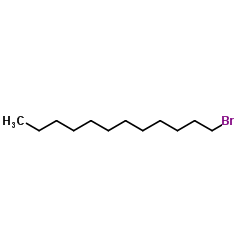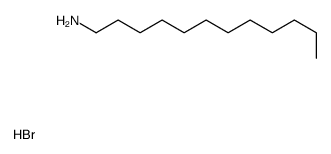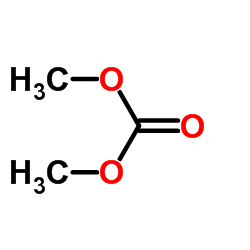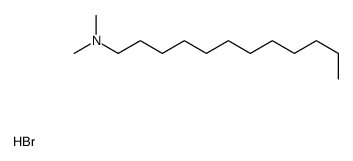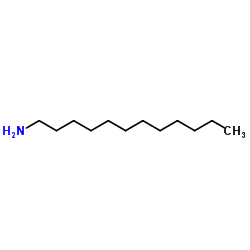DTAB

DTAB structure
|
Common Name | DTAB | ||
|---|---|---|---|---|
| CAS Number | 1119-94-4 | Molecular Weight | 308.341 | |
| Density | N/A | Boiling Point | N/A | |
| Molecular Formula | C15H34BrN | Melting Point | 246 °C (dec.)(lit.) | |
| MSDS | Chinese USA | Flash Point | 246°C | |
| Symbol |


GHS07, GHS09 |
Signal Word | Warning | |
Use of DTABDodecyltrimethylammonium bromide (DTAB) is a surfactant. Dodecyltrimethylammonium bromide interacts with DNA and changes the mechanical properties of DNA on binding and the specific binding parameters of the interaction[1]. |
| Name | dodecyltrimethylammonium bromide |
|---|---|
| Synonym | More Synonyms |
| Description | Dodecyltrimethylammonium bromide (DTAB) is a surfactant. Dodecyltrimethylammonium bromide interacts with DNA and changes the mechanical properties of DNA on binding and the specific binding parameters of the interaction[1]. |
|---|---|
| Related Catalog | |
| References |
| Melting Point | 246 °C (dec.)(lit.) |
|---|---|
| Molecular Formula | C15H34BrN |
| Molecular Weight | 308.341 |
| Flash Point | 246°C |
| Exact Mass | 307.187469 |
| LogP | 1.61750 |
| Water Solubility | soluble |
CHEMICAL IDENTIFICATION
HEALTH HAZARD DATAACUTE TOXICITY DATA
|
| Symbol |


GHS07, GHS09 |
|---|---|
| Signal Word | Warning |
| Hazard Statements | H302-H315-H319-H335-H410 |
| Precautionary Statements | P261-P273-P305 + P351 + P338-P501 |
| Personal Protective Equipment | dust mask type N95 (US);Eyeshields;Gloves |
| Hazard Codes | Xn:Harmful |
| Risk Phrases | R22;R36/37/38 |
| Safety Phrases | S26-S36-S37/39 |
| RIDADR | UN3077 |
| WGK Germany | 3 |
| RTECS | BQ3195000 |
| Packaging Group | III |
| Hazard Class | 9 |
| HS Code | 2923900090 |
|
~% 
DTAB CAS#:1119-94-4 |
| Literature: Bulletin de la Societe Chimique de France, , p. 634 Journal of the American Chemical Society, , vol. 65, p. 693 US2228369 , ; Zeitschrift fuer Naturforschung, , vol. 9b, p. 169,172 |
|
~% 
DTAB CAS#:1119-94-4 |
| Literature: Advanced Synthesis and Catalysis, , vol. 349, # 7 p. 1095 - 1101 |
|
~% 
DTAB CAS#:1119-94-4 |
| Literature: Advanced Synthesis and Catalysis, , vol. 349, # 7 p. 1095 - 1101 |
|
~% 
DTAB CAS#:1119-94-4 |
| Literature: Chemistry - A European Journal, , vol. 18, # 47 p. 15021 - 15030 |
|
~% 
DTAB CAS#:1119-94-4 |
| Literature: Bulletin of the Chemical Society of Japan, , vol. 76, # 10 p. 1903 - 1910 |
| HS Code | 2923900090 |
|---|---|
| Summary | 2923900090 other quaternary ammonium salts and hydroxides。Supervision conditions:None。VAT:17.0%。Tax rebate rate:9.0%。MFN tariff:6.5%。General tariff:30.0% |
|
Probing competitive interactions in quaternary formulations.
J. Colloid. Interface Sci. 454 , 35-43, (2015) The interaction of amphiphilic block copolymers of the poly(ethylene oxide)-poly(propylene oxide)-poly(ethylene oxide) (PEO-PPO-PEO) group with small molecule surfactants may be "tuned" by the presenc... |
|
|
Salt effect on microscopic structure and stability of colloidal complex obtained from neutral/polyelectrolyte block copolymer and oppositely charged surfactant.
Colloids Surf. B Biointerfaces 99 , 127-35, (2012) The salt effect on complex formation of poly(acrylamide)-block-poly(acrylic acid) (PAM-b-PAA) and dodecyltrimethylammonium bromide (DTAB) at different NaBr concentrations, C(NaBr), was investigated by... |
|
|
Analysis of plasma nucleotides in rat by micellar electrokinetic capillary chromatography/electrospray ionization mass spectrometry.
Rapid Commun. Mass Spectrom. 26(12) , 1426-36, (2012) The aim of this study was to establish a simultaneous quantitative analysis method of nine endogenous nucleotides in rat plasma using micellar electrokinetic capillary chromatography/electrospray ioni... |
| Dodecyl trimethyl ammonium bromide |
| Lauryltrimethylammonium Bromide |
| dodecyl trimethylammonium bromide |
| N,N,N-Trimethyldodecan-1-aminium bromide |
| n-Dodecyl trimethylammonium bromide |
| Dodecyltrimethylammonium bromide |
| N,N,N-Trimethyl-1-dodecanaminium bromide |
| 1-Dodecanaminium, N,N,N-trimethyl-, bromide (1:1) |
| DTAB |
| MFCD00011767 |
| dodecyl(trimethyl)ammonium bromide |
| Dodecyltrimethylammonium bromide (DTAB) |
| dodecyl(trimethyl)azanium,bromide |
| Laurtrimonium bromide |
| EINECS 214-290-3 |
